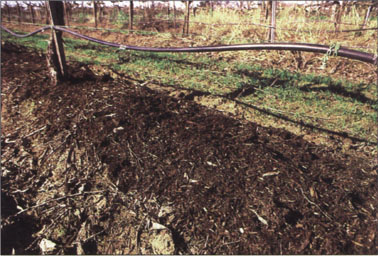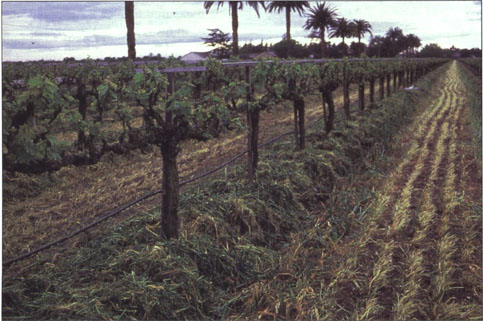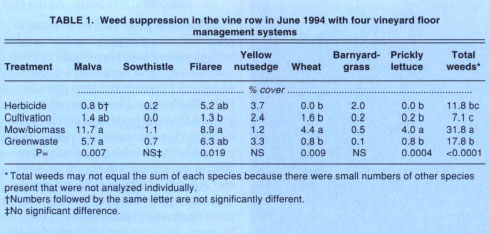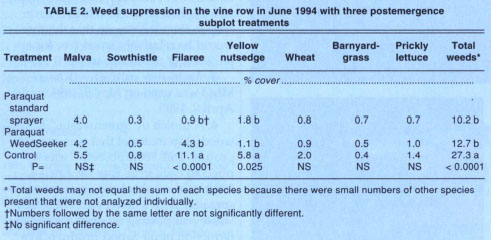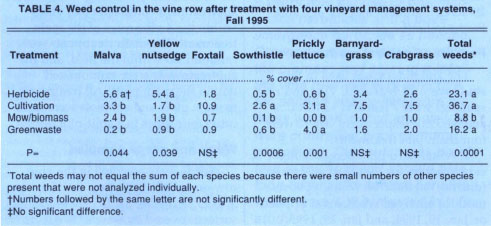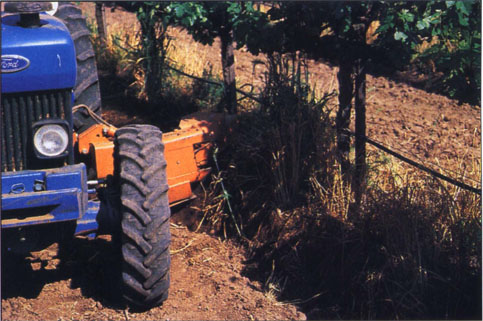All Issues
Four weed management systems compared: Mulch plus herbicides effectively control vineyard weeds
Publication Information
California Agriculture 51(2):14-18. https://doi.org/10.3733/ca.v051n02p14
Published March 01, 1997
PDF | Citation | Permissions
Abstract
Mulches have been used for many years to control weeds by smothering the weed seedlings. A 2-year study in a Lodi grape vineyard compared the weed-control effectiveness of herbicides, cultivation, cover crop biomass and wood-chip mulch and the cost of these practices. The most effective and least expensive treatment over the 2 years was the use of preemergence herbicides and a post-emergence herbicide as needed. Growing cover crops, chopping the biomass and placing it into the vine row was very effective the second year, when more biomass was produced and weeds were controlled prior to mulch placement. The mulch was persistent in the field and should give long-term weed-control benefits, which were not evaluated in this study.
Full text
Composted “greenwaste” mulch was applied in the vine row for weed control. The wood chips cost more than the other treatments, but they controlled weeds well and half the chips were still in the vineyard after the second year.
Weed management with herbicides in the vine row has been very successful for the control of annual weeds and some perennial weeds. However, weed species change as herbicides in different families are used, and unless different herbicides are used a weed species may become more severe than before herbicides were used. When annual weeds are controlled, some perennial weeds become more common and are more difficult to control. Herbicide costs have increased as new herbicides become available. In addition, there is interest in reducing pesticide inputs into the vineyard and in managing vegetation in the row by other methods, while at the same time growing cover crops between the vine rows.
Mulches have been used for many years to control weeds by smothering the weed seedlings. Mulches are commonly used in the landscape to suppress emergence and growth of weeds. At the same time that weeds are controlled, crop growth is often enhanced by reduced fluctuation in soil temperature and moisture. Depending on the type and coarseness of the mulch, 2 to 6 inches of material is needed to control most annual weeds. Many perennial weeds such as field bindweed are not controlled well with organic mulches.
Biomass from cover crop was chopped and transported into the vine row as mulch. This method was especially effective when herbicides were applied prior to chopping, cleaning the vine row for efficient biomass application.
There is interest in using mulches such as biomass grown between the vine rows in the vineyard, or organic material placed in the vine row, to reduce weeds. At the same time, new California regulations (AB939) require cities to reduce the amount of waste material sent to landfills. Increased dumping fees and the need to divert material from the landfills are incentives for communities to divert yard waste and wood-product material to other uses. There could be a benefit to farmers in using this material if there is a continuous source of clean (free of weed seeds and pathogens) mulch. Using mulch for partial weed control may make it possible to reduce herbicide use and give the grower another option for weed management.
The costs of various practices for weed management in vineyards have not been comparatively evaluated against the use of mulches. To determine the applicability of different weed-control practices in vineyards and the cost of these practices, we initiated a study in November 1993 in a 29-acre zinfandel vineyard at Kautz Farms in Lodi.
Four weed-control methods
The zinfandel vines used in this study were 20 years old. Vine and row spacings were 7 feet and 12 feet (2.1 and 3 65 m), respectively. There were four main plot treatments:
-
A standard preemergence herbicide program for the weed spectrum (diuron, oxyfluorfen with glyphosate used for emerged weeds) was applied on Jan. 10, 1994, and Jan. 19, 1995.
-
Biomass produced from a cereal grain cover crop mix (wheat, oat and barley) was planted broadcast in November 1993 and drilled in a 6-foot-wide area between the vine rows in 1994. The biomass from the top growth was chopped and conveyed into the vine row using a Trimax flail mower with a Mulchmasta conveyer behind the mower on March 19, 1994, and April 10, 1995. In 1994, no herbicide was applied to the vine rows prior to mowing and mulching the biomass. In February 1995, glyphosate was applied to the weeds and cover crop in the vine row so that the row would be relatively weed-free for application of the mulch in April 1995.
-
An in-row cultivator (Kimco Mfg.) was used on May 5, 1994, and April 8, 1995.
-
A mulch of “greenwaste,” a wood-chip material that was coarsely ground and “composted,” was applied to each vine row on April 4, 1994, with a wheel-driven manure spreader with a conveyor. The green-waste composting was not a complete reduction of the wood products to a fine organic planting mixture.
Three subtreatments were established within the main plots: (1) a banded postemergence application of paraquat using a standard high-volume boom sprayer; (2) an application of paraquat using a sprayer (WeedSeeker) that recognizes and sprays only the green plants in the vine row; and (3) an untreated plot. The subtreatments were applied on May 26, 1994, and May 3, 1995. Each main treatment consisted of 4 vine rows, each 208 vines long. Each subtreatment consisted of 40 vines within the 4 vine rows of the main treatment. The main treatments were randomized within the field, and the subtreatments were randomized within the main plots. All treatments to main plots and subplots were replicated four times in a split-plot design.
Weed and grape samples
Weeds were sampled in the vine row on June 1, 1994, Aug. 3, 1994, June 3, 1995, and Aug. 31, 1995. The ground surface covered by weeds (% cover) was measured using a 2.7 ft2 quadrat placed in the center of the row. Averages were taken from 10 samples per plot. On June 3, 1995, weeds were sampled differently and were counted at 1-foot intervals along a 100-foot transect.
TABLE 4. Weed control in the vine row after treatment with four vineyard management systems, Fall 1995
Biomass of the cover crop was measured from samples collected from 10.8 ft2 quadrats before each spring mowing. The amount of biomass was also evaluated on Aug. 30, 1995, and April 12, 1996, by removing the mulch material in a 2.7 ft2 quadrat within the vine row, drying the material at 158°F for 48 hours, then measuring the dry weight.
Sugar content in grapes was measured to determine if bare soil versus mulched soil influenced the maturity of the grapes at harvest. Grape samples were collected from 5 clusters per vine at 10-vine intervals from the middle 2 rows of each subplot (three 30-cluster samples per replication for each main treatment). Each grape sample was crushed and the mean of two readings from a refractometer was taken. Results were evaluated and analyzed using ANOVA techniques for the split-plot design.
Biomass and greenwaste
At the first mowing of the cover crop (March 19, 1994), 2.0 tons/acre of dry biomass were placed in the vine row. In April 1995, when the biomass was mowed, 4.2 tons/acre of biomass were produced because of the greater growth of the cover crop. The biomass of the greenwaste applied to the vine row in 1994 was 62 dry tons/acre, with no replenishment of the material in 1995. This produced a cover of 2.5 to 3 inches of mulch. In August 1995, about 2 years after the start of the study, there were 3.6 tons/acre of dry chopped biomass (accumulation of two mowings) and 40 tons/acre of greenwaste in the vine row. In April 1996, there were 2.6 tons/acre of biomass from cover crop mowing and 31.6 tons/acre of greenwaste in the vine row.
Weed control
Winter weed control in the vine row was excellent with the preemergence herbicides diuron and oxyfluorfen with glyphosate for post-emergent control of existing weeds (table 1). The herbicide-treated area had fewer malva (cheeseweed), prickly lettuce, wheat and total weeds compared to the area where the cover crops were mowed and the biomass deposited in the vine row. Weed numbers were highest in plots that had received biomass from a cover crop (table 1). Part of the reason for this greater number of weeds was that a cereal cover crop had been broadcast on the vine row in 1993 and was not adequately killed before the biomass was deposited. The cereal crop prevented even application of mulch, causing gaps in coverage of the soil. Cultivation in the vine row in April reduced filaree, wheat, prickly lettuce and total weeds compared to the cover crop/biomass treatment but was only different from the greenwaste mulch in total weeds in June. In June, there was no difference in weeds between cultivation and herbicide treatment (table 1).
When we compared the broadcast, boom-sprayer treatment to the visual-sprayer treatment, there were no differences in weed numbers in the vine row. There were fewer filaree, yellow nutsedge and total weeds compared to an untreated control area (table 2). Paraquat applied with either sprayer failed to kill some mature weeds.
In the spring of 1995, after 2 seasons of treatments, the total weed cover in the vine row was greatest in the area that had been cultivated (table 3). The total weed number was not significantly different between the herbicide treatment and the two mulched treatments (table 3). A postemergence application of glyphosate was used to kill the weeds before mowing and mulching, so the berm was essentially free of weeds when the mulch was applied. Prickly lettuce was most common in the cultivated and greenwaste vine rows. The greenwaste mulch was persistent in the row and reduced weed cover compared to the cultivation treatment. There was no difference in the weed cover between the two sprayer types, when averaged across main treatments (data not shown).
Cultivating weeds in the vine row with a hydraulic cultivator was effective for the winter annual and spring weeds, but was less effective in the late summer.
In the fall of 1995, after 2 years of treatments, malva (cheeseweed) and yellow nutsedge cover were greatest in the herbicide treatment (table 4). Other treatments were not different for these weeds. There was no difference between treatments for foxtail, barnyardgrass and crabgrass. Common sowthistle was more common in the cultivation treatment, and prickly lettuce was higher in the cultivation and greenwaste treatments. The amount of prickly lettuce in the greenwaste was probably greater because the mulch was compact and of fine texture rather than a loose, open straw mulch from the cover crop. There were significantly fewer weeds in the cover crop/biomass treatment in the second year than in any other treatment (table 4).
There was a 64 to 72% cover of the soil with mulch by the cover crop/biomass and greenwaste treatments, respectively. This corresponded to a total of 3.6 tons/acre and 40 tons/acre of dry mulch in the cover crop/biomass and greenwaste treatments, respectively, by the fall of 1995 (table 5).
Grape maturity
Over the 2-year period there was no difference in brix (sugar percent) between any of the treatments (data not shown). There was a slight indication that the two treatments with a mulch might have a slightly lower brix in 1995, but the differences were not significant. Also, there were no differences between type of sprayer application of paraquat and a control area (data not shown), when compared over all treatments.
Economic comparisons
Main management systems
The economic comparison of the various treatments took into account the machinery costs; other costs such as materials, including herbicides and greenwaste; and total costs for a commercial vineyard. Within machinery costs, the tractor size, cost of the equipment, fuel used, labor and overhead costs were determined. The lowest direct costs, on a vineyard acre basis, were for use of a preemergence herbicide each year and glyphosate or paraquat as a postemergence herbicide as needed (table 6). The preemergence treatment was 50% of the cost of the next least-expensive treatment, although it would need to be applied each year.
The cost of the “greenwaste” woodchip mulch per vine acre ($187.28) was much greater than the cost of any of the other treatments. However, much of the wood chips (51%) was present after the second year in the field, so long-term weed control efficacy of this treatment may make it more cost effective. Better weed control with greenwaste might have been achieved if the greenwaste had been applied uniformly. A coarse, open mulch might be more effective than the fine greenwaste material used here. Also, there are no data to indicate the overall effect of this treatment on the long-term health of the soil.
Used for a single cultivation per year, the in-row cultivator was the most expensive treatment on a year-to-year basis ($58.35 and $64.20 for the 2 years). The costs for cultivation are high because of the high cost of the machinery and its associated overhead cost. At this site, chopping the cover crop and placing the chopped material in the vine row for weed control was cheaper than cultivation (table 6). The cost of planting the cover crop is included in the cost of the treatment. The long-term benefit from the degradation of the mulch will also benefit the vines and soil.
Sprayer systems
Machinery costs for the different types of sprayers were included in the costs. The standard sprayer was a Ford tractor with a pull-behind applicator using a power take off (PTO) shaft to run a diaphragm pump. The “weed-seeking” visual sprayer was mounted on either a Honda All Terrain Vehicle (ATV) or, during the second year, a John Deere Gator. The machinery and fuel costs were greater with the standard sprayer than with the visual sprayer (table 7). Water carrier volume and herbicide were less with the visual sprayer compared to the standard sprayer. The least spray solution used was in the cultivation area in 1994 because of the high percentage of bare soil owing to the recent cultivation. In 1995, the spray volume, and thus the amount of paraquat used, was minimal in the preemergence, cultivation and cover crop/biomass treatments compared to the greenwaste treatment (table 8).
TABLE 7. Cost comparison of paraquat applied with a standard boom sprayer compared to a “weed-seeking” visual sprayer in a vineyard over 2 years
TABLE 8. Comparison of standard and visual sprayers using paraquat for weed control in vineyard management systems
When averaged over all treatments, the use of the visual sprayer compared to the standard boom sprayer would have saved more than 60% of the paraquat spray because of the reduced cover of the weeds by the other mulches. In addition, the faster speed through the vineyard and the reduced labor costs because there was less tank filling and time traveling between the water source and the field helped to reduce overall costs of the visual sprayer.
Summary
The most effective and least expensive treatment at the site over the 2 years of this study were preemergence herbicides and a postemergence herbicide as needed. Cultivation with a Kimco Mfg. cultivator was effective for the winter annual and spring weeds, but was less effective in the late summer and was one of the most expensive treatments. Long-term effects of cultivation were not taken into account. Growing cover crops, chopping the biomass and placing it into the vine row was very effective the second year, when more biomass was produced. This method was especially effective with the use of glyphosate prior to chopping, which gave a clean vine row for efficient biomass application. Even though they were not distributed uniformly, the greenwaste wood chips gave good weed control. The mulch was persistent in the field and should give long-term weed-control benefits; therefore, the short-term direct cost is not the best way to evaluate this product.



